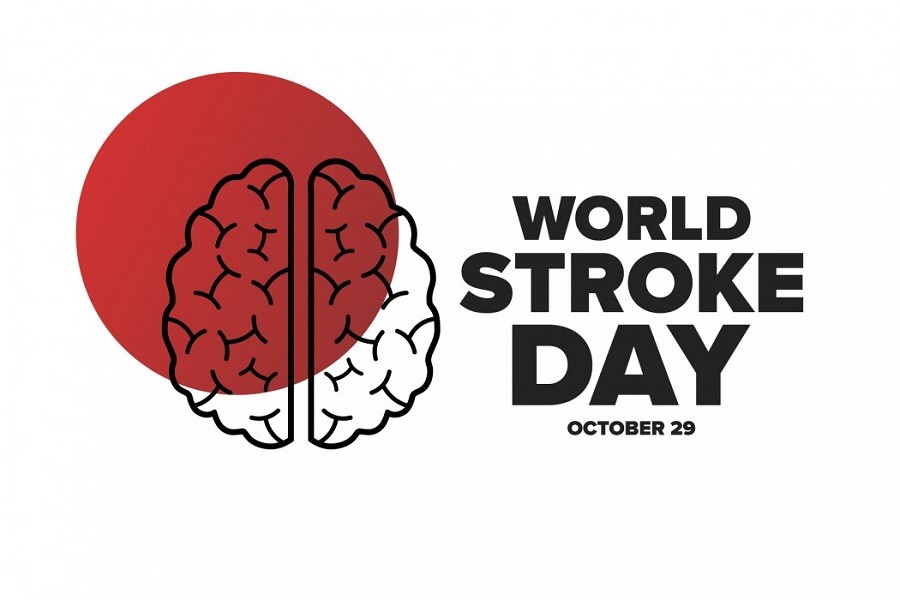
Published :
Updated :

According to the World Health Organisation, stroke is the second leading cause of death in the world and according to their data, about 15 million people suffer from stroke every year.
Of those, 5 million die and another 5 million become permanently disabled or paralyzed. In many cases, the rate of stroke is increasing due to a lack of awareness.
Let’s know stroke
Stroke is a disease of the brain. It is called a cerebrovascular accident in medical science. When the blood supply to the brain is disrupted for any reason, the brain tissue is damaged due to lack of blood-- this damage is called a stroke.
There are two types of strokes. Ischemic and Hemorrhagic stroke.
When clots form in the blood vessels of the brain and cause obstruction in the supply of oxygen-rich blood resulting in the death of brain parenchyma, it is called an Ischemic stroke. 85 per cent of strokes are Ischemic strokes.
When small blood vessels in the brain rupture and bleed, the pressure in the brain increases and the nerves in the brain die due to lack of oxygen which is called a Hemorrhagic stroke.
Causes
There are several reasons for this.
Irreversible causes: The risk of stroke increases with age. Males are more affected than females. People with hereditary factors, older patients with heart or vascular diseases are at higher risk.
Reversible causes: High blood pressure, diabetes, blood clots in the blood vessels, smoking, tobacco usage, obesity, lack of blood clotting ingredients, taking birth control pills, etc.
How to understand a stroke
- Sudden weakening or numbness of one side of the body-face, arms, legs.
- Sudden confusion, trouble in speaking or understanding speech.
- Having difficulty seeing or seeing any two things.
- Fainting and excessive headaches and vomiting with no known cause.
- Convulsion.
- Some people may also experience bladder or bowel control problems, depression, difficulty in controlling or expressing emotions, etc.
Identifying a stroke patient FAST
Learning the acronym ‘FAST’ is a good way to remember the symptoms of a stroke. This can help a person seek prompt treatment. FAST stands for:
Face drooping: If the person tries to smile, does one side of their face droop?
Arm weakness: If the person tries to raise both their arms, does one arm drift downward?
Speech difficulty: If the person tries to repeat a simple phrase, is their speech slurred or unusual?
Time to act: If any of these symptoms are occurring, contact the emergency services immediately.
CT scan of the brain determines the type of stroke while MRI of the brain diagnose the cause of Ischemic stroke. In some cases, Carotid Ultrasonogram or Carotid angiography aid in the diagnosis.
The Golden Hour
Four and a half hours after the stroke is the golden hour. During this period, if the blood flow to the arteries of the brain can be normalised, it is possible to prevent post-stroke damage.
The first goal of treatment is to bring the heart rate and blood pressure back to normal. Certain Hemorrhagic cases may need operative intervention to save the patient’s life.
Treatment after stroke
Many people can return to work and lead a normal life by taking physical, speech and occupational therapy as part of a proper rehabilitation program in the aftermath of a stroke.
Stroke does not mean death, it just needs timely treatment. The most important factor in the management of acute Ischemic stroke is time.
A patient with Ischemic stroke loses 1.9 million brain cells every minute. About 1.4 billion nerve connections are destroyed every minute and 12 kilometres (7.5 miles) of nerve fibres are lost in the same amount of time. With the right decision at the right time and the right treatment, this damage and mortality can be reduced.
Stroke Prevention and World Stroke Day
Stroke is a preventable disease. It is better to prevent this disease than to treat it. The first step is to change the lifestyle and eating habits-- consumption of vegetables, exercising regularly and avoiding fatty foods are initials.
Along with those, smoking tobacco leaves should be avoided. High blood pressure and diabetes should be controlled through regular medication and exercise.
World Stroke Day is celebrated on October 29th every year to raise public awareness about stroke. The World Stroke Organization (WSO) started it in 2006. Since then, the day has been celebrated every year through various programs.
This article is written by Dr Mohammad Nazrul Hossain, an Associate Professor and the Head Department of Neurosurgery at Ibrahim Cardiac Hospital and Research Institute (ICHRI). [email protected]
Dr Maisha Jamil, Observer at Department of Neurosurgery, ICHRI, assisted in data collection.


 For all latest news, follow The Financial Express Google News channel.
For all latest news, follow The Financial Express Google News channel.